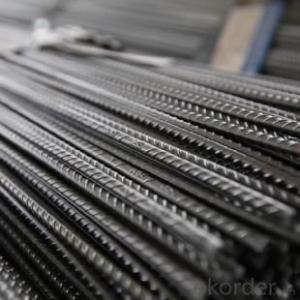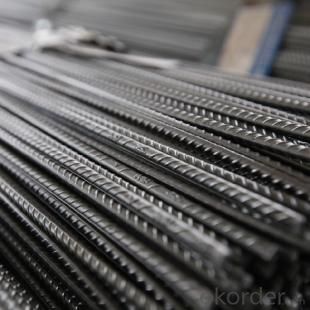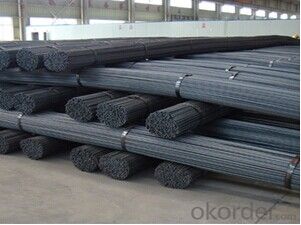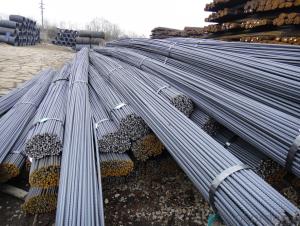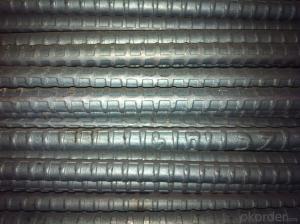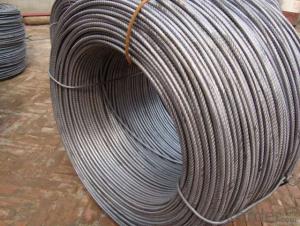GB Standard HRB400 Steel Deformed Bar 10mm/12mm
- Loading Port:
- Tianjin
- Payment Terms:
- TT or LC
- Min Order Qty:
- 25 m.t
- Supply Capability:
- 20000 m.t/month
OKorder Service Pledge
OKorder Financial Service
You Might Also Like
GB Standard HRB400 Steel Deformed Bar 10mm/12mm
Description:
-Standard: GB
-Material: HRB400
-Specification:
| Diameter(mm) | Section Area(mm2) | Mass(Kg/m) | Length(m) |
| 10 | 78.54 | 0.617 | 9, 12 or as customs' request |
| 12 | 113.1 | 0.888 | 9, 12 or as customs' request |
Chemical Composition(%) of GB Standard HRB400 Steel Deformed Bar 10mm/12mm:
| C | Mn | Si | S | P | V |
| ≤0.25 | ≤1.60 | ≤0.08 | ≤0.045 | ≤0.045 | 0.04-0.12 |
Mechanical Properties of GB Standard HRB400 Steel Deformed Bar 10mm/12mm:
Yield Strength (N/cm²) | Tensile Strength (N/cm²) | Elongation (%) |
≥400 | ≥570 | ≥14 |
Usage and Applications of GB Standard HRB400 Steel Deformed Bar 10mm/12mm:
Deformed bar is widely used in buildings, bridges, roads and other engineering construction. Big to highways, railways, bridges, culverts, tunnels, public facilities such as flood control, dam, small to housing construction, beam, column, wall and the foundation of the plate, deformed bar is an integral structure material. With the development of world economy and the vigorous development of infrastructure construction, real estate, the demand for deformed bar will be larger and larger.
Packaging & Delivery of GB Standard HRB400 Steel Deformed Bar 10mm/12mm:
Packaging Detail: products are packed in bundle and then shipped by container or bulk vessel, deformed bar is usually naked strapping delivery, when storing, please pay attention to moisture proof. The performance of rust will produce adverse effect.
Each bundle weight: 2-3MT, or as required
Payment term: TT or L/C
Delivery Detail: within 45 days after received advanced payment or LC.
Label: to be specified by customer, generally, each bundle has 1-2 labels
Trade terms: FOB, CFR, CIF
Images of GB Standard HRB400 Steel Deformed Bar 10mm/12mm:


*If you would like to get our price, please inform us the size, standard/material and quantity. Thank you very much for your attention.
- Q: How are steel rebars protected against damage from construction equipment?
- Steel rebars are typically protected against damage from construction equipment through the use of rebar caps or plastic sleeves. These protective measures are designed to cover the exposed ends of the rebars, preventing any direct impact or damage from heavy machinery. Additionally, construction workers are trained to handle equipment carefully around rebars to minimize the risk of accidental damage.
- Q: How are steel rebars classified based on their surface patterns?
- Steel rebars are classified based on their surface patterns into three main categories: plain, deformed, and ribbed. Plain rebars have a smooth surface and are primarily used in applications where the concrete needs to slide along the steel surface. Deformed rebars have raised patterns or deformations on their surface, enhancing the bond strength between the steel and the concrete. Ribbed rebars have continuous longitudinal ribs that provide additional surface area for the concrete to adhere to, resulting in better load transfer capabilities.
- Q: Are there any limitations or restrictions on using steel rebars in construction?
- Yes, there are certain limitations and restrictions on using steel rebars in construction. Here are some of them: 1. Corrosion: Steel rebars are prone to corrosion when exposed to moisture and certain chemical environments. This can weaken the rebars over time and compromise the structural integrity of the construction. To mitigate this limitation, protective coatings or stainless steel rebars can be used. 2. Fire Resistance: Steel rebars can lose their strength and become malleable when exposed to high temperatures during a fire. This can lead to structural failure. Fireproofing measures such as fire-resistant coatings or using concrete encasement can help enhance the fire resistance of steel rebars. 3. Weight: Steel rebars can be quite heavy, especially for large-scale construction projects. This can pose challenges during transportation, handling, and installation. It may require additional labor or equipment to handle the weight, which can increase project costs. 4. Thermal Expansion: Steel has a relatively high coefficient of thermal expansion, meaning it expands and contracts significantly with temperature changes. This can lead to thermal stresses and potential cracking in the concrete surrounding the rebars. Proper design techniques and the use of expansion joints can help accommodate thermal expansion and mitigate this limitation. 5. Electromagnetic Interference: Steel rebars can interfere with electromagnetic signals, such as those used in communication systems or sensitive electronic equipment. This limitation needs to be considered when constructing buildings with specific requirements, such as hospitals or laboratories. 6. Cost: The cost of steel rebars can fluctuate depending on market conditions, availability, and quality. This can impact the overall budget of construction projects, especially when large quantities of rebars are required. It is important to note that while steel rebars have limitations, they have been widely used in construction due to their strength, durability, and availability. Proper design, construction techniques, and maintenance can help overcome these limitations and ensure the safe and efficient use of steel rebars in buildings and infrastructure.
- Q: Why the longitudinal tie bar adopts screw steel bar, and the transverse transmission bar adopts light round steel bar.
- Longitudinal tie rod. Longitudinal seam usually has longitudinal contraction joint and longitudinal construction joint two kinds, two kinds of longitudinal joints should be provided with tie rod. The bar shall be designed with the length of the threaded steel to ensure the bond between it and the concrete, and the diameter and spacing of the tie rod shall also be guaranteed. Thus, the tie rod can not provide enough tensile force, and when the concrete faceplate is contracted, the longitudinal joint is pulled apart to form a crack.
- Q: What is the role of steel rebars in reducing concrete creep?
- Steel rebars play a crucial role in reducing concrete creep by providing additional tensile strength to the concrete structure. As concrete is prone to creep, which is the gradual deformation over time due to sustained loads, rebars act as reinforcement to counteract this phenomenon. By resisting the tension forces that cause creep, steel rebars help maintain the structural integrity and stability of the concrete, thus minimizing any potential deformations or cracks.
- Q: Are there any alternatives to steel rebars?
- There are multiple options available instead of steel rebars. One such option is the utilization of fiber-reinforced polymer (FRP) rebars, which consist of high-strength fibers embedded in a polymer matrix. FRP rebars present various advantages over traditional steel rebars, such as resistance to corrosion, high tensile strength, and lightweight characteristics. Moreover, they are non-magnetic and electrically non-conductive, making them appropriate for areas with concerns regarding electromagnetic interference. Another alternative is the employment of basalt rebars, which are manufactured from fibers derived from basalt rock. Basalt rebars offer similar benefits to FRP rebars, including corrosion resistance and high tensile strength. Furthermore, certain manufacturers have developed alternative materials like bamboo, carbon fiber, and glass fiber rebars, which have also displayed potential in specific applications. Nevertheless, it is crucial to consider that the selection of alternative rebars depends on the specific requirements of a project, and factors like cost, availability, and adherence to local building codes should be taken into account when choosing an alternative to steel rebars.
- Q: What are the different types of steel rebars used in road constructions?
- Road constructions commonly utilize various types of steel rebars. These include: 1. Mild steel rebars: These are the most frequently employed rebars in road constructions. They consist of low carbon steel and possess a smooth surface. Mild steel rebars are renowned for their durability and strength, making them suitable for a range of road construction applications. 2. High-strength rebars: Crafted from high-strength steel, these rebars possess a greater yield strength compared to mild steel rebars. They are utilized in road constructions that require enhanced load-bearing capacity, such as bridges and highways. 3. Epoxy-coated rebars: These rebars are coated with epoxy resin to enhance their resistance to corrosion. They are commonly used in road constructions in areas exposed to moisture and chemicals, such as coastal regions. 4. Galvanized rebars: These rebars feature a zinc coating that provides protection against corrosion. They are particularly suitable for road constructions in regions with high humidity or a high risk of corrosion. 5. Stainless steel rebars: Constructed from stainless steel, these rebars exhibit exceptional corrosion resistance. They are frequently employed in road constructions that necessitate long-term durability and resistance to corrosion, such as tunnels and underground structures. Selecting the appropriate type of steel rebar for road constructions is crucial and should be based on specific project requirements, including load-bearing capacity, exposure to corrosion, and environmental conditions. Consulting structural engineers and adhering to local construction codes and standards is essential to ensure the successful implementation of road construction projects.
- Q: What is the process of bending steel rebars into shapes other than straight bars?
- The process of bending steel rebars into shapes other than straight bars typically involves using specialized machinery, such as a rebar bending machine or a hydraulic bender. The rebars are placed in the machine, which applies force to bend them into the desired shape. The operator may follow blueprints or use templates to ensure accurate bending. This process is commonly used in construction and concrete reinforcement projects to create custom shapes that fit specific architectural or structural requirements.
- Q: Can steel rebars be used in seismic-resistant structures?
- Yes, steel rebars can be used in seismic-resistant structures. Steel rebars have excellent tensile strength and ductility, making them an ideal reinforcement material for concrete structures in earthquake-prone areas. When properly designed and installed, steel rebars can help increase the structural integrity and resistance of buildings to seismic forces. They provide additional strength and flexibility to the concrete, allowing it to better withstand the lateral and vertical loads exerted during an earthquake. Moreover, steel rebars can effectively dissipate and absorb the energy generated during seismic events, reducing the potential for structural damage or collapse.
- Q: Can steel rebars be bent without compromising their strength?
- Yes, steel rebars can be bent without compromising their strength. Steel rebars are designed to have a high tensile strength, which allows them to withstand bending and stretching forces without breaking or losing their structural integrity. The bending process involves applying a controlled amount of force to the rebar, which causes the material to deform and take on a new shape. However, it is important to ensure that the bending is done within the recommended limits and guidelines provided by the manufacturer or industry standards. Excessive bending beyond the specified limits can lead to microcracks or other defects that may compromise the strength of the rebar. Therefore, it is crucial to follow proper bending techniques and use the appropriate equipment to ensure that the steel rebars maintain their strength even after being bent.
Send your message to us
GB Standard HRB400 Steel Deformed Bar 10mm/12mm
- Loading Port:
- Tianjin
- Payment Terms:
- TT or LC
- Min Order Qty:
- 25 m.t
- Supply Capability:
- 20000 m.t/month
OKorder Service Pledge
OKorder Financial Service
Similar products
Hot products
Hot Searches
Related keywords
